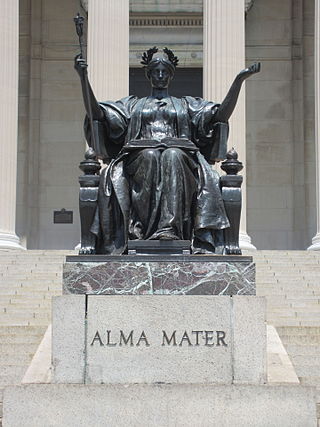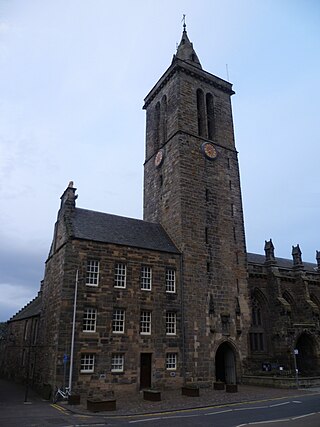Related Research Articles

Higher education is tertiary education leading to the award of an academic degree. Higher education, which makes up a component of post-secondary, third-level, or tertiary education, is an optional final stage of formal learning that occurs after completion of secondary education. It represents levels 5, 6, 7, and 8 of the 2011 version of the International Standard Classification of Education structure. Tertiary education at a nondegree level is sometimes referred to as further education or continuing education as distinct from higher education.

A medieval university was a corporation organized during the Middle Ages for the purposes of higher education. The first Western European institutions generally considered to be universities were established in present-day Italy, including the Kingdoms of Sicily and Naples, and the Kingdoms of England, France, Spain, Portugal, and Scotland between the 11th and 15th centuries for the study of the arts and the higher disciplines of theology, law, and medicine. These universities evolved from much older Christian cathedral schools and monastic schools, and it is difficult to define the exact date when they became true universities, though the lists of studia generalia for higher education in Europe held by the Vatican are a useful guide.

Robert de Sorbon was a French theologian, the chaplain of Louis IX of France, and founder of the Sorbonne college in Paris.

The University of Siena in Siena, Tuscany, is one of the oldest and first publicly funded universities in Italy. Originally called Studium Senese, the institution was founded in 1240. It had around 16,000 students in 2022, which is nearly one-third of Siena's total population of around 53,000. Today, the University of Siena is best known for its Schools of Law, Medicine, and Economics and Management.

A financial endowment is a legal structure for managing, and in many cases indefinitely perpetuating, a pool of financial, real estate, or other investments for a specific purpose according to the will of its founders and donors. Endowments are often structured so that the inflation-adjusted principal or "corpus" value is kept intact, while a portion of the fund can be spent each year, utilizing a prudent spending policy.

The Collegio di Spagna is a college for Spanish students at the University of Bologna, Italy, which has been functioning since the 14th century. Its full original name in English translation was the College of Saint Clement of the Spaniards. It has been under the Royal patronage of the Spanish Crown since 1488, as authorized by Pope Innocent VIII.

European universities date from the founding of the University of Bologna in 1088 or the University of Paris. The original medieval universities arose from the Roman Catholic Church schools. Their purposes included training professionals, scientific investigation, improving society, and teaching critical thinking and research. External influences, such as Renaissance humanism, the discovery of the New World (1492), the Protestant Reformation (1517), the Age of Enlightenment, and the recurrence of political revolution, enhanced the importance of human rights and international law in the university curricula.

A university is an institution of higher education and research which awards academic degrees in several academic disciplines. Universities typically offer both undergraduate and postgraduate programs.
The Collège de Calvi, also called Calvi or Little Sorbonne, was a college of the University of Paris.

Authentica habita, or Privilegium Scholasticum, was a document written in 1155 ca. by the Emperor Frederick I Barbarossa. In it, he set out for the first time some of the rules, rights and privileges of students and scholars. It is an important precursor to the formation of medieval universities in Europe.
Henry of Oyta was a German theologian and nominalist philosopher.

Education in Medieval Scotland includes all forms of education within the modern borders of Scotland, between the departure of the Romans from Britain in the fifth century, until the establishment of the Renaissance late fifteenth century and early sixteenth century. Few sources on Scottish education survived the Medieval era. In the early Middle Ages, Scotland was an oral society, with verbal rather than literary education. Though there are indications of a Gaelic education system similar to that of Ireland, few details are known. The establishment of Christianity from the sixth century brought Latin to Scotland as a scholarly and written language. Monasteries served as major repositories of knowledge and education, often running schools.
Hilde De Ridder-Symoens was a Belgian historian. She was Professor of Medieval History at the Free University of Amsterdam (1986–2001) and Professor of Early Modern History at the University of Ghent (2001–2008). Her research focuses on educational history and the history of universities. She edited the first two volumes of Cambridge University Press's A History of the University in Europe. Together with C.M. Ridderikhoff she published Les livres des procurateurs de la nation germanique de l'ancienne Université d'Orléans, 1444-1602.
Historia rerum ubique gestarum locorumque descriptio is an unfinished book written by Enea Silvio Piccolomini, who was later elected Pope Pius II in 1458. It was written originally in Latin, and the title roughly translates to "History of Achievements Everywhere." The original intent of the book was to record the history of human existence across the globe, as well as a historical and geographical cosmography. Piccolomini planned three sections, on Europe, Asia, and Africa. Only the sections on Europe and Asia were completed in 1458 and 1461, respectively. The incomplete book was published in Venice in 1477 after his death, as Historia rerum ubique gestarum. The published version of the book also told the work of Eratosthenes on the size of the earth and was very heavily read and annotated by Christopher Columbus on his voyages. Columbus used this as one of the many works from which he pulled his ideas about the Earth. The copy that was used by Columbus to prepare for his voyages, along with his annotations, is now kept in the Columbine Library in Seville Cathedral in Seville, Spain. Historia rerum ubique gestarum has been translated into many different languages today, and copies of the book can sell for up to $2,200 USD.
References
- ↑ Formerly known as Standing Conference of Rectors, Presidents, and Vice Chancellors of the European Universities (CRE)
- 1 2 Edward Grant: "A History of the University in Europe. Volume 1: Universities in the Middle Ages by Hilde de Ridder-Symoens" (Review), History of Education Quarterly, Vol. 33, No. 3 (1993), pp. 395–398
- 1 2 Susan Rosa: "A History of the University in Europe. Volume 1: Universities in the Middle Ages" (Review), The Sixteenth Century Journal , Vol. 28, No. 3 (1997), pp. 887–889 (887f.)
- 1 2 Christopher Ocker: "A History of the University in Europe. Volume 1: Universities in the Middle Ages" (Review), Isis , Vol. 85, No. 4 (1994), pp. 689–690
- 1 2 Walter Rüegg (ed.): A History of the University in Europe. Vol. IV: Universities Since 1945, Cambridge University Press, 2011, ISBN 978-0-521-36108-8, p. XXII
- ↑ Hilde de Ridder-Symoens (ed.): A History of the University in Europe. Vol. I: Universities in the Middle Ages, Cambridge University Press, 1992, ISBN 0-521-36105-2, p. XIII
- ↑ Edward Grant: "A History of the University in Europe. Volume 1: Universities in the Middle Ages by Hilde de Ridder-Symoens" (Review), History of Education Quarterly, Vol. 33, No. 3 (1993), pp. 395–398 (395)
- 1 2 Matthew S. Kempshall: "Universal or Particular? A History of the University in Europe, Volume I. Universities in the Middle Ages" (Review), Oxford Review of Education, Vol. 23, No. 2 (1997), pp. 203–209 (204)